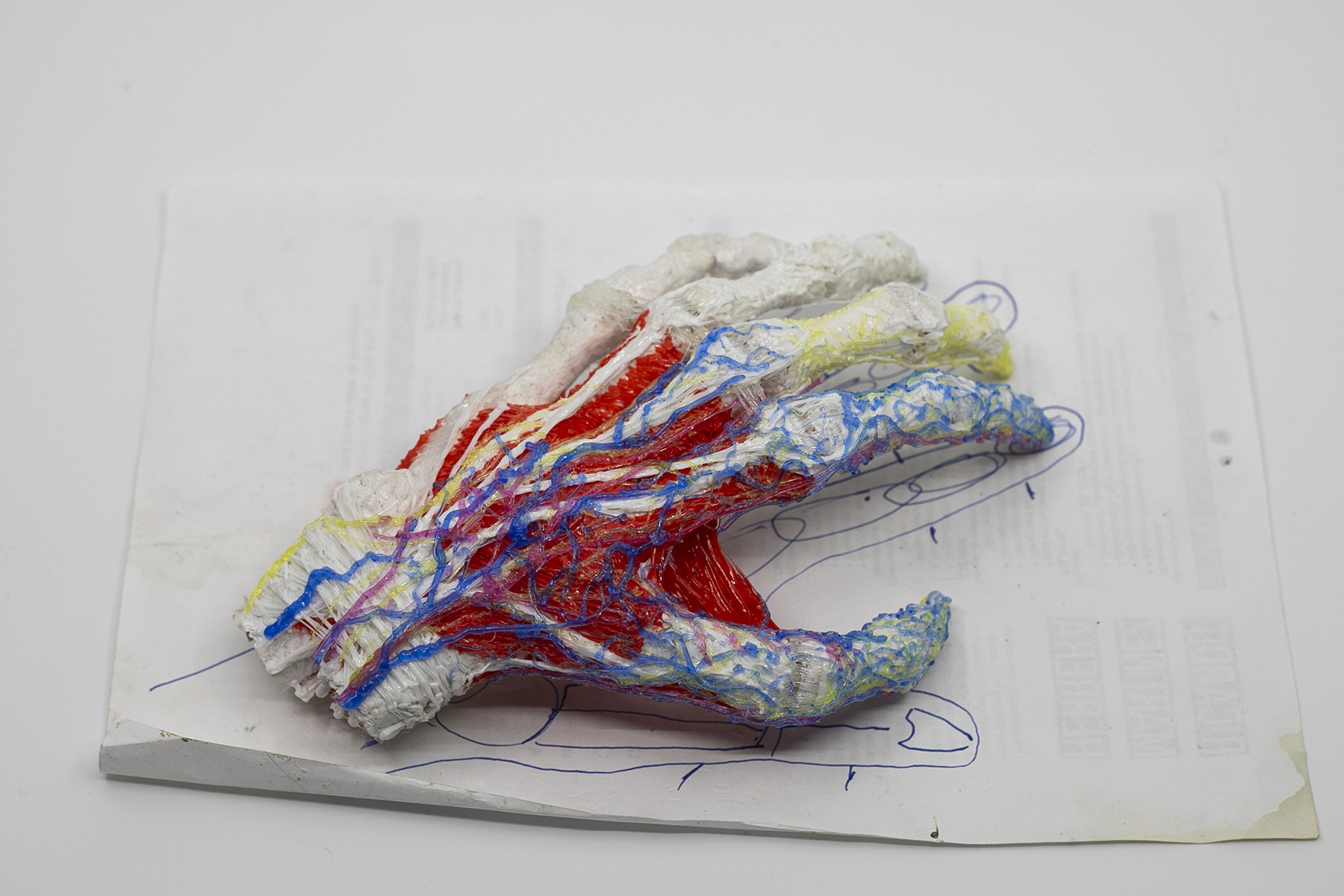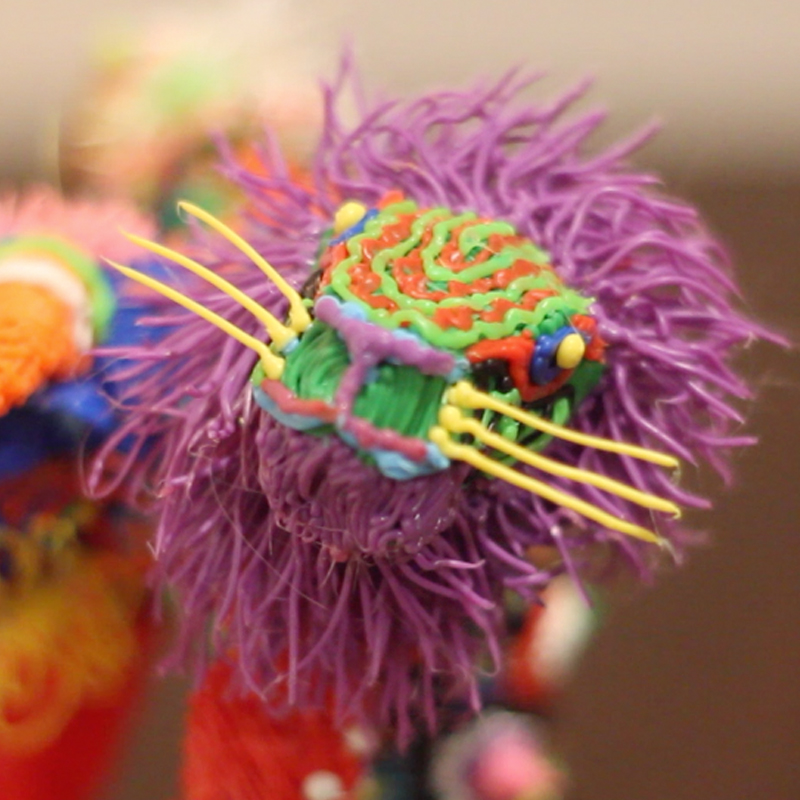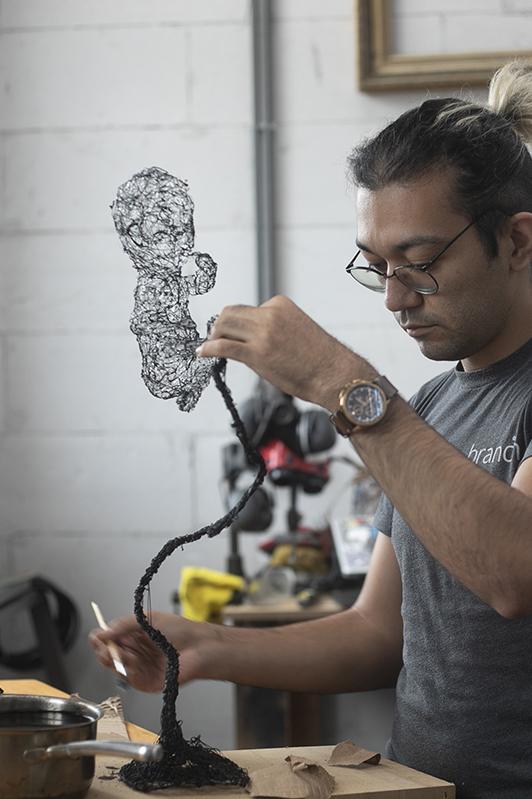Artist Ricardo Martínez Herrera spends hours creating sculptures with the 3Doodler 3D printing pen, an emerging art form that is becoming an appreciated medium for talented minds. Inspired by his own Mexican culture, global trends, and human anatomy, the Belgium-based artist shares his passion for producing contemplative, cutting-edge works using 3D technology. His innovative vision has led him to make folkloric art, 3D drawn clothing, anatomical models, and even a tribute to Sony’s popular game for PlayStation, Death Stranding.
Usually found experimenting with new mediums and combining materials in unique ways, Herrera has sculpted some truly striking pieces to recreate iconic and traditional brightly colored Mexican folkloric art sculptures called alebrijes, from the Oaxaca region. For his series, colorful threads of ABS plastic intertwine to create fantastical creatures. Each sculpture is the product of at least eight hours of work, but, like most artists, Herrera has described how he completely overlooks time when he is deeply involved with a piece.
In his blog, the 31-year old contemporary artist revealed he had to leave his native Mexico many years ago due to extreme violence levels – a major push factor for many people who emigrate from Central America to seek safety in other countries. After finishing a Master of Fine Arts (MFA) at the Royal Academy of Fine Arts of Brussels, Belgium, where he specialized in sculpture, he became an entrepreneur and activist, founding several startups related to technology and digital art.
Herrera picked up 3D pen art techniques in 2016 when he was a resident artist for LIX pen – a manufacturer of sleek and small 3D pens – at their Belgium headquarters. But it wasn’t until he found the 3Doodler Create that he began producing serial art. Drawn to 3Doodler for its ability to outlast competitors, it has given the artist continuous use when producing sculptures. Since being launched in 2013, 3Doodler pens have allowed users to draw in the air, producing free-hand creations by heating solid plastic to 230°C, forcing it through a small nozzle as it cools.
To keep busy during the long months of COVID-19 lockdown restrictions in 2020, Herrera decided to pay tribute to the action game Death Stranding, created by legendary game designer Hideo Kojima. The result was an impressive sculpture of the Death Stranding baby. In the game, the child, dubbed BB, remains helplessly trapped in a jar, where it serves as a bridge for the main character, Sam, alerting him to ghostly apparitions from the “dead world.” Often described as an eerie element of the game, the child plays nicely with the cataclysmic world in which the characters live.
For the sculpture, that meant equally dark colors and a creepy vibe enhanced by the thin and intertwined strands of plastic extruded by the 3Doodler pen. For this piece, the artist chose transparent and black plastic, a base made of wax, and a steel wire that holds the Death Stranding baby in mid-air. After he was done creating the baby, which is in a fetal position, he laced strands of plastic around the steel wire, made to look like an umbilical cord, just like the yellow one the baby has in the game.

Realistic looking hand created with 3Doodler and 3Doodler STEM kit. Image courtesy of Ricardo Martínez Herrera.
The artist is deeply passionate about exploring human anatomy, which has recurrently shown up in his work. 3DPrint.com spoke to Herrera to understand a bit more about this phase of his art. He explained that his interest has led him to create standout sculptures that are a combination of human anatomy and mathematical or geometric perfection. In fact, much of his work deals with the contrast between the two.
For example, Herrera used a 3Doodler pen and the 3Doodler STEM kit to recreate a realistic-looking hand. The hand joints are all movable, and the tissues and veins were all made using FLEXY DoodleStrands, which allows them to flex and bend. Likewise, he used different colors and materials to distinguish bone, cartilage, muscle, veins, arteries, and nerves. The hand was featured on 3Doodler’s blog, including a full step-by-step guide on creating the piece. Following the articulated hand, the artist created a skull with the 3D pen and ABS plastic, but this time, once the original forms were complete, he decided to cast it using a lost-wax bronze technique. Called “Memento Mori”, Latin for “remember that you must die,” the piece quickly sold to a private collection.

Artist Ricardo Martínez Herrera created a skull with a 3Doodler and ABS plastic (left) and then cast it in bronze to make a sculpture called Memento Mori. Images courtesy of Ricardo Martínez Herrera.
After his work became public, Herrera was approached by neurosurgeon and researcher at University Hospital Brussels, Frederick Van Gestel, who is developing a new take on neuronavigation to provide surgeons with a 3D insight into the patient’s anatomy. The expert sees potential in Herrera’s 3D anatomical sculptures, and the two hope to work together shortly to provide more tools that can enhance learning and training for the medical community.
The artist has plans to expand his work to create lifelike sculptures of the brain and internal human anatomy using 3Doodler or another 3D printing technology. In fact, in December 2020, he received his first grant from the Wallonie-Bruxelles Federation, which funds fundamental research for French-speaking Brussel residents. The funds will be used to create art and explore human anatomy through bronze and 3D plastics in collaboration with medical practitioners.
Subscribe to Our Email Newsletter
Stay up-to-date on all the latest news from the 3D printing industry and receive information and offers from third party vendors.
You May Also Like
New Report: Semiconductor Industry to See $1.4B in 3D Printing Revenues by 2032
“The semiconductor sector has become the most strategically significant area of global industry.” Truer words are hard to come by when it comes to the modern world, and they are...
Will Photonic-Crystal Lasers Revolutionize 3D Printing?
Powder bed fusion (PBF) for metals and polymers predominantly utilizes lasers as the primary heat source. Some directed energy deposition (DED) technologies also employ lasers, while various vat polymerization methods...
3D Printing Unpeeled: Orbex Investment, IndoMIM and HP, Ultrasonic Waves
INDO-MIM has bought three HP Metal Jet S100 printers, operating two in India and one in Texas. This is a win for HP because the company has deep experience in...
3D Printing Webinar and Event Roundup: April 21, 2024
It’s another busy week of webinars and events, starting with Hannover Messe in Germany and continuing with Metalcasting Congress, Chinaplas, TechBlick’s Innovation Festival, and more. Stratasys continues its advanced training...

































